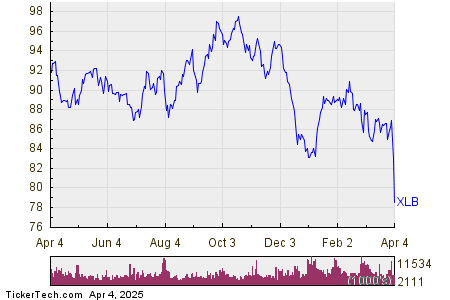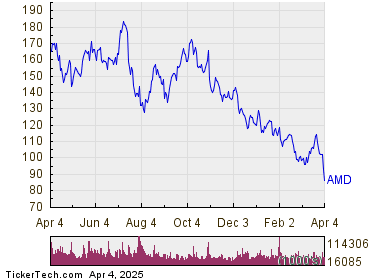Crumbling Crude Prices Prompt Concerns Over Economic Impact
May WTI crude oil (CLK25) closed Thursday down -4.76 (-6.64%) while May RBOB gasoline (RBK25) also fell, closing down -0.1667 (-7.15%).
Decline Tied to Trade War Fears and OPEC+ Production Plans
Crude oil and gasoline prices sank to three-week lows on Thursday as concerns grew over President Trump’s proposed higher tariffs, which many fear could ignite a trade war and harm global economic growth and energy demand. Additionally, a significant drop in the S&P 500, which reached a six-and-a-half month low, further undermined confidence in the economic outlook and energy consumption.
Losses in crude prices deepened after OPEC+ announced it would increase production more than previously indicated. Despite an overall decline in crude prices, the dollar index (DXY00) also fell to a six-month low, providing no relief for oil markets.
Mixed Economic Data Raises Red Flags
On Thursday, U.S. economic data primarily reflected a weaker outlook, contributing to bearish sentiment regarding energy demand. Weekly continuing claims rose by 56,000, reaching a three-and-a-third year high of 1.903 million, surpassing expectations of 1.870 million. This indicates a more challenging job market for those seeking employment. In contrast, the March ISM services index dropped by 2.7 points to a nine-month low of 50.8, which was worse than anticipated, as economists had predicted a figure of 52.9. On a more positive note, initial unemployment claims unexpectedly fell by 6,000, dropping to a seven-week low of 219,000, demonstrating some resilience in the labor market.
OPEC+ Adjusts Production Forecasts
OPEC+ accelerated crude production plans, stating an increase of 411,000 barrels per day (bpd) in May compared to just 138,000 bpd added this month. This move aims to reverse a two-year production cut, gradually restoring a total of 2.2 million bpd. The timeline for full restoration has shifted from late 2025 to September 2026. Furthermore, March saw OPEC crude production rise by 80,000 bpd to its highest level in 13 months at 27.43 million bpd.
Geopolitical Tensions and Supply Disruptions
Support for crude prices emerged earlier this week when President Trump expressed frustration at Russian President Putin regarding the lack of a ceasefire in Ukraine. Trump mentioned considering “secondary tariffs” to limit Russian crude exports if there is no resolution.
Additionally, there was a notable decline in crude oil held globally aboard tankers. Vortexa reported a 5.5% week-over-week drop in stored crude oil on stationary tankers, bringing the total to 55.67 million barrels as of March 28.
Further support for crude came when the U.S. Treasury Department sanctioned a refinery in China and 19 entities linked to Iranian crude oil shipments. These sanctions target Iranian exports amid ongoing pressure for a new nuclear deal, potentially removing up to 1.5 million bpd of Iranian crude from global markets, which adds a bullish tilt to oil prices.
Middle Eastern tensions also remain a concern, with Israeli airstrikes against Gaza ending a two-month ceasefire with Hamas. Israeli Prime Minister Netanyahu has vowed to intensify military efforts, and U.S. airstrikes against Yemen’s Houthi rebels have been characterized as “unrelenting” as they seek to stop attacks on vessels in the Red Sea.
Rising Russian Oil Exports Counterbalance Other Factors
Conversely, increased Russian oil exports pose a negative impact on crude prices. Data from Bloomberg highlights that Russian oil products exports reached a five-month high at 3.45 million bpd in March.
Moreover, new U.S. sanctions on Russia’s oil industry, announced on January 10, could impact global supply. These sanctions targeted Gazprom Neft and Surgutneftgas, responsible for about 970,000 bpd of Russian crude in late 2023, which accounted for roughly 30% of its tanker flow. Tracking data shows Russian crude exports increased by 40,000 bpd week-over-week to 3.07 million bpd as of March 30.
Weakening Chinese Demand Raises Concerns
Additionally, weakening crude oil demand from China is a bearish factor for prices. According to customs data, China’s 2024 crude imports decreased by 1.9% year-on-year, totaling 553 million metric tons. As the world’s largest crude importer, China’s demand significantly influences global oil markets.
Recent Inventory Reports and Production Levels
According to the latest EIA report released on Wednesday, U.S. crude oil inventories as of March 28 were down 4.6% compared to the seasonal five-year average. Gasoline inventories showed a 2.0% increase above the seasonal average, while distillate inventories were down 6.0%. U.S. crude oil production remained unchanged at 13.58 million bpd, slightly below the record high of 13.631 million bpd recorded in December.
Baker Hughes reported a decrease in active U.S. oil rigs, falling by two to 484 in the week ending March 28. This figure remains above the three-year low of 472 rigs recorded on January 24. The U.S. rig count has seen a decline over the past two years from a peak of 627 rigs in December 2022.
On the date of publication, Rich Asplund did not have positions in any of the securities mentioned in this article. All information and data in this article are solely for informational purposes. For more information, please view the Barchart Disclosure Policy
here.
The views and opinions expressed herein are those of the author and do not necessarily reflect those of Nasdaq, Inc.


